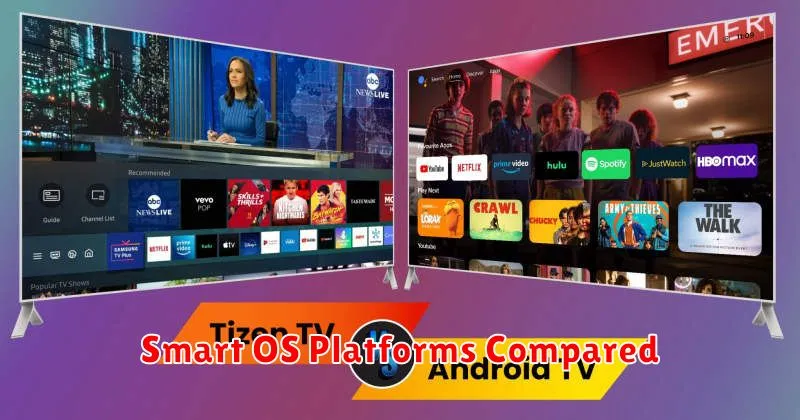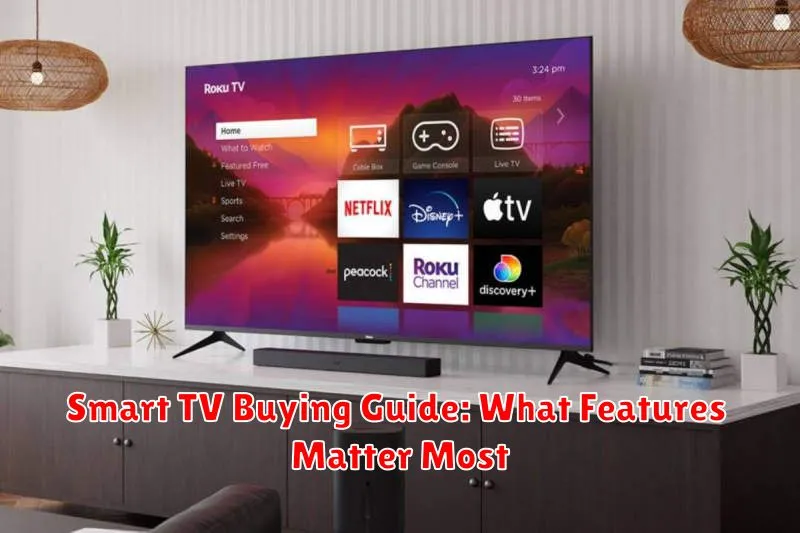Purchasing a new Smart TV can be overwhelming with the abundance of options available. This Smart TV Buying Guide aims to simplify the process by highlighting the features that truly matter most. Understanding the key specifications and functionalities will empower you to make an informed decision and select the perfect Smart TV that caters to your entertainment needs and budget. From screen size and resolution to operating system and connectivity, this guide will navigate you through the essential considerations for your Smart TV purchase.
This comprehensive Smart TV Buying Guide delves into the critical features that differentiate Smart TVs in today’s market. We will explore features such as HDR, refresh rate, and smart platform capabilities, enabling you to choose a Smart TV with the best picture quality, performance, and user experience. Whether you are a casual viewer, a movie enthusiast, or a gamer, this guide provides valuable insights to help you select the ideal Smart TV that meets your specific requirements and enhances your home entertainment setup.
Screen Size and Room Fit
One of the most critical factors when choosing a smart TV is screen size. A screen that’s too small can feel underwhelming, while an excessively large one can be overwhelming and impractical, especially in smaller rooms. Proper screen size is essential for a comfortable and immersive viewing experience.
Consider the viewing distance from your seating area to where the TV will be placed. A general rule of thumb is to divide the viewing distance (in inches) by two to get a suitable screen size (in inches). For example, if your couch is 10 feet (120 inches) away from the TV, a 60-inch screen would be appropriate.
Room size also plays a role. A larger room can accommodate a bigger screen, while a smaller room might require a more modest size. Think about the overall layout and available space to ensure the TV fits comfortably without dominating the room’s aesthetic.
Display Types: LED, OLED, QLED
Understanding display technology is crucial for selecting the right Smart TV. Three primary display types dominate the market: LED, OLED, and QLED.
LED (Light Emitting Diode) TVs are the most common and generally the most affordable. They utilize a backlight that illuminates liquid crystals to produce the image. While offering good picture quality, they can struggle with deep blacks and contrast.
OLED (Organic Light Emitting Diode) TVs utilize self-emissive pixels, meaning each pixel generates its own light. This allows for perfect black levels and incredible contrast, leading to a more vibrant and realistic image. However, OLEDs can be more expensive.
QLED (Quantum Dot Light Emitting Diode) TVs are a variation of LED technology that uses a quantum dot layer to enhance color accuracy and brightness. QLEDs offer improved color performance compared to traditional LEDs, but don’t achieve the same black levels as OLEDs.
Refresh Rate and Motion Handling
Refresh rate, measured in Hertz (Hz), indicates how many times per second the TV’s image refreshes. A higher refresh rate, such as 120Hz, generally results in smoother motion, especially noticeable in fast-paced content like sports or action movies. 60Hz is the standard, but consider 120Hz if you prioritize smooth motion clarity.
Motion handling refers to how the TV processes movement to reduce blur and judder. While a higher refresh rate helps, additional processing technologies can further enhance motion clarity. Look for terms like motion interpolation or motion smoothing. However, be aware that these features can sometimes introduce what’s known as the “soap opera effect,” which can make images appear artificially smooth.
Smart OS Platforms Compared

Choosing the right Smart TV also means selecting a suitable operating system (OS). Each platform offers a unique interface and app selection. Roku OS is known for its simplicity and wide range of streaming channels. Amazon Fire TV tightly integrates with Amazon’s services and offers a vast content library. Google TV provides a personalized experience with content recommendations powered by Google’s AI. webOS, found on LG TVs, boasts a sleek, user-friendly interface with a magic remote for intuitive navigation. Tizen, used by Samsung, offers a similar experience with a focus on gaming and smart home integration. Consider your viewing habits and preferred services when choosing a platform.
Voice Control and Smart Integration
Voice control has become a standard feature in many smart TVs, allowing you to search for content, control playback, and adjust settings using voice commands. Consider the effectiveness and responsiveness of the voice recognition system. Some TVs have far-field microphones that can pick up your voice from across the room, while others require you to use a remote control.
Smart integration refers to the TV’s ability to connect to the internet and access various streaming services, apps, and other online content. Look for a TV with a robust smart platform that offers a wide selection of apps and services and is easy to navigate. Compatibility with your existing smart home ecosystem is also an important factor. Can you control your TV with your smart speaker or integrate it with other smart devices in your home?
Ports and Connectivity Options
Connectivity is crucial for a smart TV. Consider the ports available. HDMI ports are essential for connecting Blu-ray players, game consoles, and soundbars. Ensure your chosen TV has enough HDMI ports for your needs. USB ports allow you to connect external storage devices for media playback.
Beyond physical connections, consider wireless options. Wi-Fi is standard for accessing streaming services and online content. Bluetooth enables connection with wireless headphones, keyboards, and other peripherals. Some TVs also offer Ethernet ports for a more stable wired network connection.
Recommended Brands and Models
While specific model recommendations can quickly become outdated, we can highlight some consistently well-regarded brands known for their quality and features.
High-end: Brands like Sony, LG, and Samsung often offer premium models with cutting-edge technology, superior picture quality, and robust smart features. These are excellent choices if budget is less of a concern.
Mid-range: TCL, Vizio, and Hisense provide competitive models with good value, balancing performance and affordability. These brands often incorporate many of the same smart features found in higher-end models without the premium price tag.
Budget-friendly: For those seeking more basic smart functionality and prioritizing value, brands like Insignia and Toshiba offer entry-level options. These TVs are suitable for casual viewing and less demanding smart TV usage.

